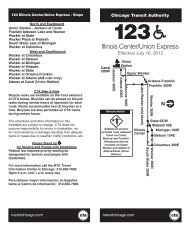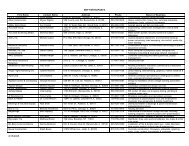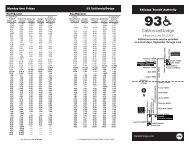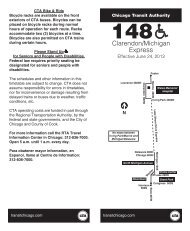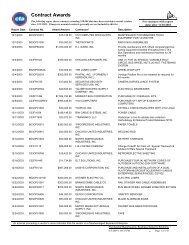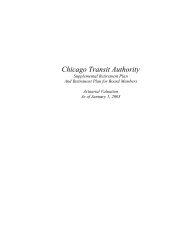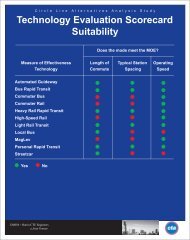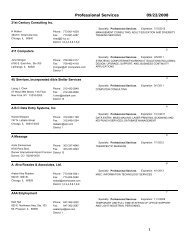Table Of Contents - Chicago Transit Authority
Table Of Contents - Chicago Transit Authority
Table Of Contents - Chicago Transit Authority
You also want an ePaper? Increase the reach of your titles
YUMPU automatically turns print PDFs into web optimized ePapers that Google loves.
CTA Express Airport Train Service Business Plan<br />
being added to the free-running time to account for railroad congestion due to the volume of Blue Line<br />
trains in operation. Therefore, the scheduled running time via this alignment would vary between 28 and<br />
33 minutes depending on the time of day.<br />
The other alternative is a new, dedicated, double-track alignment which would follow the Kennedy<br />
Expressway (I-90/94) and Union Pacific Railroad right-of-way from <strong>Chicago</strong> Avenue to north of Foster<br />
Avenue. On its north end, the new tracks would join the Kennedy Expressway median express tracks<br />
that extend out to Cumberland Avenue as described above. This line has the advantage of significantly<br />
reducing the amount of interference with ordinary Blue Line trains, which is reflected in an estimated<br />
free-running time of 26 minutes. A further measure of the reduced interference is that a range of only<br />
zero to two minutes is expected to be added to the free-running time to account for Blue Line train traffic<br />
the expresses would encounter only on relatively short track segments between O’Hare and Cumberland<br />
and between <strong>Chicago</strong>/Milwaukee and 108 N. State Street.<br />
Although this Kennedy Expressway-UP alternative would have significantly higher capital costs, the added<br />
track capacity it would bring could open the possibility for some ordinary (regular fare) Blue Line trains to<br />
also use this new track in “limited stop” service between downtown and Jefferson Park-Rosemont. In this<br />
manner, the benefits of the express track infrastructure could directly extend to ordinary CTA Blue Line<br />
customers—particularly those making relatively long work trips from <strong>Chicago</strong>’s South, Southwest, and<br />
West Sides—who would see transit travel times to jobs in the O’Hare area reduced significantly. The<br />
benefits of the extra track to ordinary CTA customers could also provide rationale for leveraging a major<br />
private sector capital contribution with some public support to pay for the necessary infrastructure.<br />
The estimation of the running times were developed using schedule “snapshots” that incorporated actual<br />
CTA train performance data. However, it is recommended that computer-based capacity modeling be<br />
done for the entire express route (from O’Hare to 108 N. State Street to Midway) for the complete<br />
operating day. In particular, capacity of the O’Hare terminal and of the shared sections of the doubletrack<br />
Blue Line should be studied further. Also of interest is the capacity of affected portions of the State<br />
Street Subway and the south side elevated tracks shared with the Green and Orange Lines.<br />
One issue with the possibility of longer peak period Express Service running times if the Blue Line<br />
elevated alignment alternative is developed is the adequacy of equipment layovers. This may preclude<br />
clock-face departures ( :00, :15, etc.) at all times, and may also require extremely short layover times at<br />
O’Hare. This is another reason why the Kennedy Expressway-UP alignment may be preferred to the Blue<br />
Line elevated alignment alternative.<br />
Dwell times at 108 N. State Street may be short in several instances throughout the operating day. For<br />
example, at the peak of the PM train flow, some trains may get only four minutes’ dwell at 108 N. State<br />
Street. This will limit in-service attention (trash pick up, etc.) on those trips. However, this was done in<br />
the preliminary schedules to allow sufficient time at both the O’Hare and Midway terminals for light<br />
cleaning of the consists.<br />
Another concern particularly associated with the Blue Line elevated alignment alternative is the overall<br />
reliability of the Express Service, particularly as it might be affected by the operation of the ordinary Blue<br />
and Red Line trains, in addition to the effect the express trains may have on the local services. CTA train<br />
performance data used in the production of the schedule “snapshots” indicates that there is a degree of<br />
variability in the local train operation from one day to the next. Some of the causes of this variability<br />
may not be under CTA’s control, while other aspects may be. If the Express Service relies on manual<br />
49





